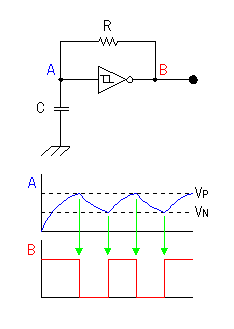Operation explanation
of the square wave oscillator (1)
 Because the electric charge isn't stored up in the capacitor(C) when turning on the power of the oscillator, the voltage of the both edges of the capacitor becomes 0 V. Because the input (the A point) of the inverter is 0 V, it becomes the L level and the output (the B point) of the inverter becomes the H level (+5V). When the B point is +5 V, the electric current flows to the capacitor(C) through the resistor(R) and gradually the electric charge stores up in the capacitor. When the electric charge stores up in the capacitor(C), the voltage of the both edges of the capacitor rises. When the A point reaches VP, the input of the inverter becomes the H level. Then, the output (B) of the inverter becomes the L level (0V) rapidly. When the B point becomes 0 V, as for the electric charge of the capacitor(C), it begins the discharge through the resistor (R). When discharging by the electric charge of the capacitor, the voltage of the both edges of the capacitor falls. The input of the inverter becomes the L level when the voltage of the A point falls and reaches VN. Then, the output (the B point) of the inverter becomes the H level (+5V) rapidly. In this way, the voltage of the A point goes between VP and VN and the voltage of the B point changes rectangularly. The duty (the ratio of the time that the output is L level and the H level) of this oscillator is the fixation. Because the input electric current of the inverter is related, it is not 50%. The time that the output becomes 0 V is shorter. |